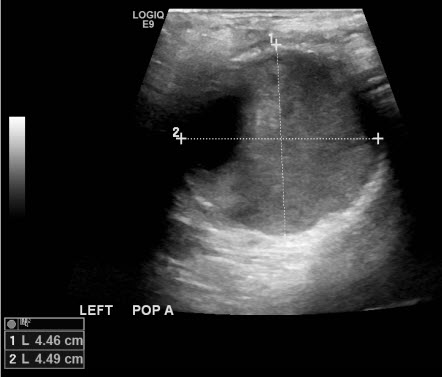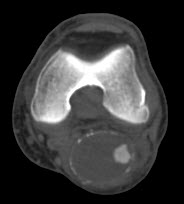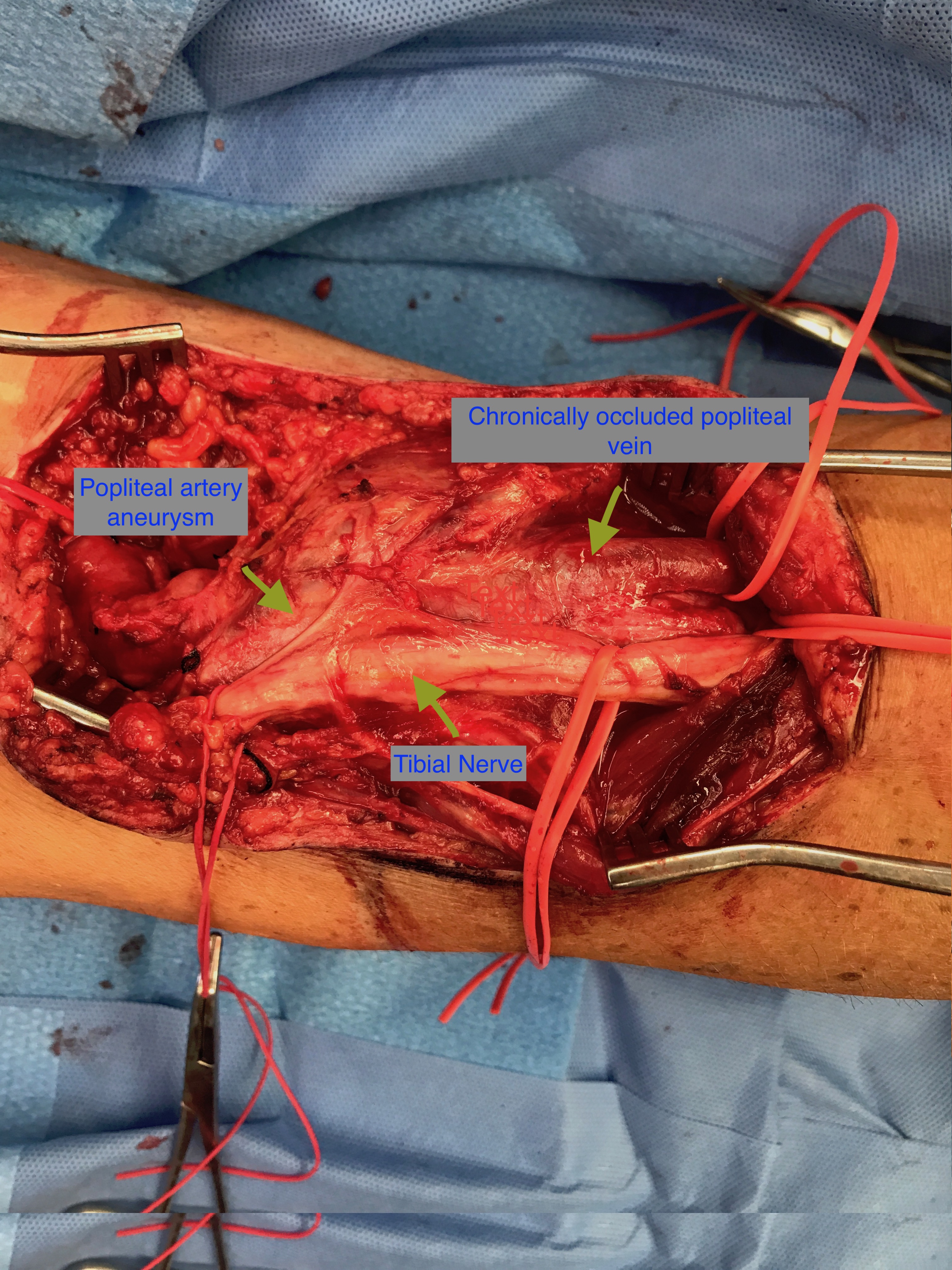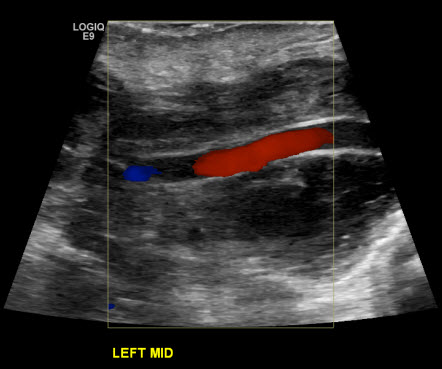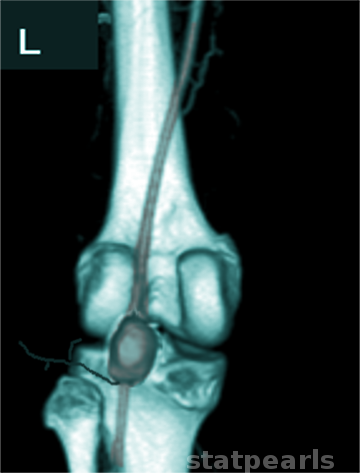[1]
Jacob T, Hingorani A, Ascher E. Examination of the apoptotic pathway and proteolysis in the pathogenesis of popliteal artery aneurysms. European journal of vascular and endovascular surgery : the official journal of the European Society for Vascular Surgery. 2001 Jul:22(1):77-85
[PubMed PMID: 11461108]
[2]
Johnston KW, Rutherford RB, Tilson MD, Shah DM, Hollier L, Stanley JC. Suggested standards for reporting on arterial aneurysms. Subcommittee on Reporting Standards for Arterial Aneurysms, Ad Hoc Committee on Reporting Standards, Society for Vascular Surgery and North American Chapter, International Society for Cardiovascular Surgery. Journal of vascular surgery. 1991 Mar:13(3):452-8
[PubMed PMID: 1999868]
[3]
Wolf YG, Kobzantsev Z, Zelmanovich L. Size of normal and aneurysmal popliteal arteries: a duplex ultrasound study. Journal of vascular surgery. 2006 Mar:43(3):488-92
[PubMed PMID: 16520160]
[4]
Thompson RW, Liao S, Curci JA. Vascular smooth muscle cell apoptosis in abdominal aortic aneurysms. Coronary artery disease. 1997 Oct:8(10):623-31
[PubMed PMID: 9457444]
[5]
Kropman RH, Schrijver AM, Kelder JC, Moll FL, de Vries JP. Clinical outcome of acute leg ischaemia due to thrombosed popliteal artery aneurysm: systematic review of 895 cases. European journal of vascular and endovascular surgery : the official journal of the European Society for Vascular Surgery. 2010 Apr:39(4):452-7. doi: 10.1016/j.ejvs.2009.11.010. Epub 2010 Feb 12
[PubMed PMID: 20153667]
Level 2 (mid-level) evidence
[6]
Lawrence PF, Lorenzo-Rivero S, Lyon JL. The incidence of iliac, femoral, and popliteal artery aneurysms in hospitalized patients. Journal of vascular surgery. 1995 Oct:22(4):409-15; discussion 415-6
[PubMed PMID: 7563401]
[7]
Trickett JP, Scott RA, Tilney HS. Screening and management of asymptomatic popliteal aneurysms. Journal of medical screening. 2002:9(2):92-3
[PubMed PMID: 12133930]
[8]
Diwan A, Sarkar R, Stanley JC, Zelenock GB, Wakefield TW. Incidence of femoral and popliteal artery aneurysms in patients with abdominal aortic aneurysms. Journal of vascular surgery. 2000 May:31(5):863-9
[PubMed PMID: 10805875]
[9]
Huang Y, Gloviczki P, Noel AA, Sullivan TM, Kalra M, Gullerud RE, Hoskin TL, Bower TC. Early complications and long-term outcome after open surgical treatment of popliteal artery aneurysms: is exclusion with saphenous vein bypass still the gold standard? Journal of vascular surgery. 2007 Apr:45(4):706-713; discussion 713-5
[PubMed PMID: 17398379]
[10]
Piechota-Polanczyk A, Jozkowicz A, Nowak W, Eilenberg W, Neumayer C, Malinski T, Huk I, Brostjan C. The Abdominal Aortic Aneurysm and Intraluminal Thrombus: Current Concepts of Development and Treatment. Frontiers in cardiovascular medicine. 2015:2():19. doi: 10.3389/fcvm.2015.00019. Epub 2015 May 26
[PubMed PMID: 26664891]
[11]
Diamond SL. Systems Analysis of Thrombus Formation. Circulation research. 2016 Apr 29:118(9):1348-62. doi: 10.1161/CIRCRESAHA.115.306824. Epub
[PubMed PMID: 27126646]
[12]
Martelli E, Ippoliti A, Ventoruzzo G, De Vivo G, Ascoli Marchetti A, Pistolese GR. Popliteal artery aneurysms. Factors associated with thromboembolism and graft failure. International angiology : a journal of the International Union of Angiology. 2004 Mar:23(1):54-65
[PubMed PMID: 15156131]
[13]
Lilly MP, Flinn WR, McCarthy WJ 3rd, Courtney DF, Yao JS, Bergan JJ. The effect of distal arterial anatomy on the success of popliteal aneurysm repair. Journal of vascular surgery. 1988 May:7(5):653-60
[PubMed PMID: 3285037]
[14]
Inahara T, Toledo AC. Complications and treatment of popliteal aneurysms. Surgery. 1978 Dec:84(6):775-83
[PubMed PMID: 715697]
[15]
Dawson I, Sie RB, van Bockel JH. Atherosclerotic popliteal aneurysm. The British journal of surgery. 1997 Mar:84(3):293-9
[PubMed PMID: 9117288]
[16]
Robinson WP 3rd, Belkin M. Acute limb ischemia due to popliteal artery aneurysm: a continuing surgical challenge. Seminars in vascular surgery. 2009 Mar:22(1):17-24. doi: 10.1053/j.semvascsurg.2008.12.005. Epub
[PubMed PMID: 19298931]
[17]
Hardman RL, Jazaeri O, Yi J, Smith M, Gupta R. Overview of classification systems in peripheral artery disease. Seminars in interventional radiology. 2014 Dec:31(4):378-88. doi: 10.1055/s-0034-1393976. Epub
[PubMed PMID: 25435665]
Level 3 (low-level) evidence
[18]
Ravn H, Bergqvist D, Björck M, Swedish Vascular Registry. Nationwide study of the outcome of popliteal artery aneurysms treated surgically. The British journal of surgery. 2007 Aug:94(8):970-7
[PubMed PMID: 17520712]
[19]
Gibbons CP. Thrombolysis or immediate surgery for thrombosed popliteal aneurysms? European journal of vascular and endovascular surgery : the official journal of the European Society for Vascular Surgery. 2010 Apr:39(4):458-9. doi: 10.1016/j.ejvs.2009.12.016. Epub 2010 Jan 8
[PubMed PMID: 20060334]
[20]
Gabrielli R, Rosati MS, Carra A, Vitale S, Siani A. Outcome after preoperative or intraoperative use of intra-arterial urokinase thrombolysis for acute popliteal artery thrombosis and leg ischemia. The Thoracic and cardiovascular surgeon. 2015 Mar:63(2):164-7. doi: 10.1055/s-0034-1378189. Epub 2014 Jun 9
[PubMed PMID: 24911902]
[21]
Dorigo W, Pulli R, Turini F, Pratesi G, Credi G, Innocenti AA, Pratesi C. Acute leg ischaemia from thrombosed popliteal artery aneurysms: role of preoperative thrombolysis. European journal of vascular and endovascular surgery : the official journal of the European Society for Vascular Surgery. 2002 Mar:23(3):251-4
[PubMed PMID: 11914013]

